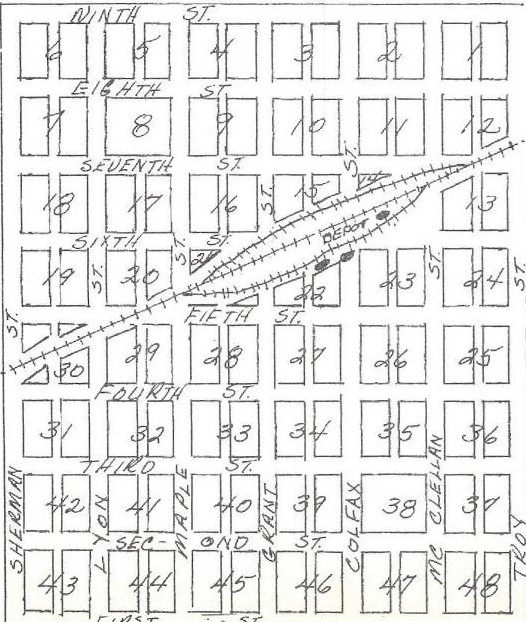
With the advent of the railroad into Clarke County in the year 1868 Murray (or Oakland as it was first named) sprang into existence. As there was another Oakland in Iowa the village was renamed Murray in honor of a railroad engineer. The town was laid out in 1868 by Mr. Sigler of Osceola and Mr. Mallory of Chariton. The original plat consisted of 120 acres divided into 48 blocks each 316 feet square. Murray has since been extended by three additions —Mallorys North Addition, Mallorys West Addition and Layton Addition on the Northwest. These were all laid out as residential lots. It is now 1 mile square. The first building on the town-site was a temporary warehouse erected by the railroad company. The building was afterward torn down and replaced by a substantial station building. The new building burned in 1873 but was rebuilt. This station burned in 1886 and was replaced by another building just west of the old site. This building was torn down in 1967. The next building on the village site was a hotel put up by Sigler and Mallory who employed James Cree to run it. This building burned down in the autumn of 1886 when owned by George Lochrie. The third building was put up by A B Straub, which was later used many years by 0. E. Garrett for a general mercantile establishment. The next building was just west of the hotel building and was erected by L. K. Martindale. It also burned in 1886. Following these first structures much of the town has burned and been rebuilt through the years. Mr. Hiram Lamb was the first to build a home for himself in Murray. He moved here from Hopeville in 1868 and at that time only two other shanties were to be seen. J. E. Wick and Alfred Davis came the same fall. Mr. Wick, a lumber dealer on his way to Creston with a car load of lumber, was forced to unload in Murray as this was the end of the railroad at this time. He would have to haul his lumber by wagon the rest of the way. He decided to sell his lumber in Murray and his success was so great he decided to build and make Murray his home. His was the second home here. The description of Mr. Davis' arrival will be included later. |
Several firsts in the community were attributed to the Wick family. They planted the first tree (which was across the sidewalk from where the post office now stands). Mr. Wick was the first Justice of the Peace and married the first couple here, which was Mr. & Mrs. Alonzo Wilson of Hopeville. The post office was established in 1868 and was in the General Store Building. A. B. Straub was appointed first postmaster. The railroad reached Murray in 1868 and 16 teams of oxen were used on the roadbed as the railway pushed west into the prairie out of Osceola. The railroad was built on to Afton in the fall of 1868 where work was stopped til the following spring. Mr. Wick, with the help of T. S. Cochran, published the first newspaper in Murray which was called the Murray Reporter in 1872. It was later changed to The Murray News by Mr. Wick and Mr. Harding in 1877. His was the first lumber yard in Murray. He also helped with the cutting of the tall prairie grass to lay out the streets and the walks for the town. Murray was incorporated in the autumn of 1880, the first meeting of the council being held December 7. In the year 1872 a Mr. Simmons, a miller, came to town and built a grist mill. This was a large barnlike structure of three stories. Two stories above ground were used as grinding and storage rooms and the lower room was below ground and contained the machinery to run the grinding machines in the upper stories. This mill was located on the property now the residence of Glen Kleinback. A brick kiln was built and operated on Sherman Street where it did a thrivingbusiness for several years. The first real depression in Murray and the surrounding settlements was the panic of 1873 which brought hard times to the settlers; eggs were 5¢ per dozen; butter 8¢ a pound; cattle and hogs 2¢ a pound; wheat 50¢ a bushel; and corn 8¢ a bushel.
|

Return to Murray page
Last revised September 20, 2013